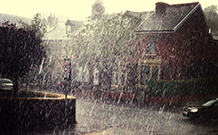 In recent years, Denmark has experienced a number of sudden, extreme rainfall events. These events, known as cloudbursts, overwhelm stormwater systems and cause flood damage to homes and businesses. One way to help municipalities prepare for the next cloudburst is to map the “bluespots” in the landscape—low-lying areas without natural outflows. Planners can use bluespot maps to decide where preventive measures will best protect buildings and infrastructure.
In recent years, Denmark has experienced a number of sudden, extreme rainfall events. These events, known as cloudbursts, overwhelm stormwater systems and cause flood damage to homes and businesses. One way to help municipalities prepare for the next cloudburst is to map the “bluespots” in the landscape—low-lying areas without natural outflows. Planners can use bluespot maps to decide where preventive measures will best protect buildings and infrastructure.
In the new Find Areas at Risk of Flooding in a Cloudburst lesson on the Learn ArcGIS website, you’ll examine and run a geoprocessing model that finds bluespots in a study area near Copenhagen. You’ll then compare the bluespots to building locations. For more experienced users, a second model calculates the volumes of bluespots and estimates how much rainfall would be needed to fill them. The models can also be run with your own elevation data. Ready-made versions for both metric and U.S. units, as well as for situations where building footprint data is not available, are included with the downloadable data.
This Learn ArcGIS lesson was created by Dr. Thomas Balstrøm of the University of Copenhagen.


Article Discussion: